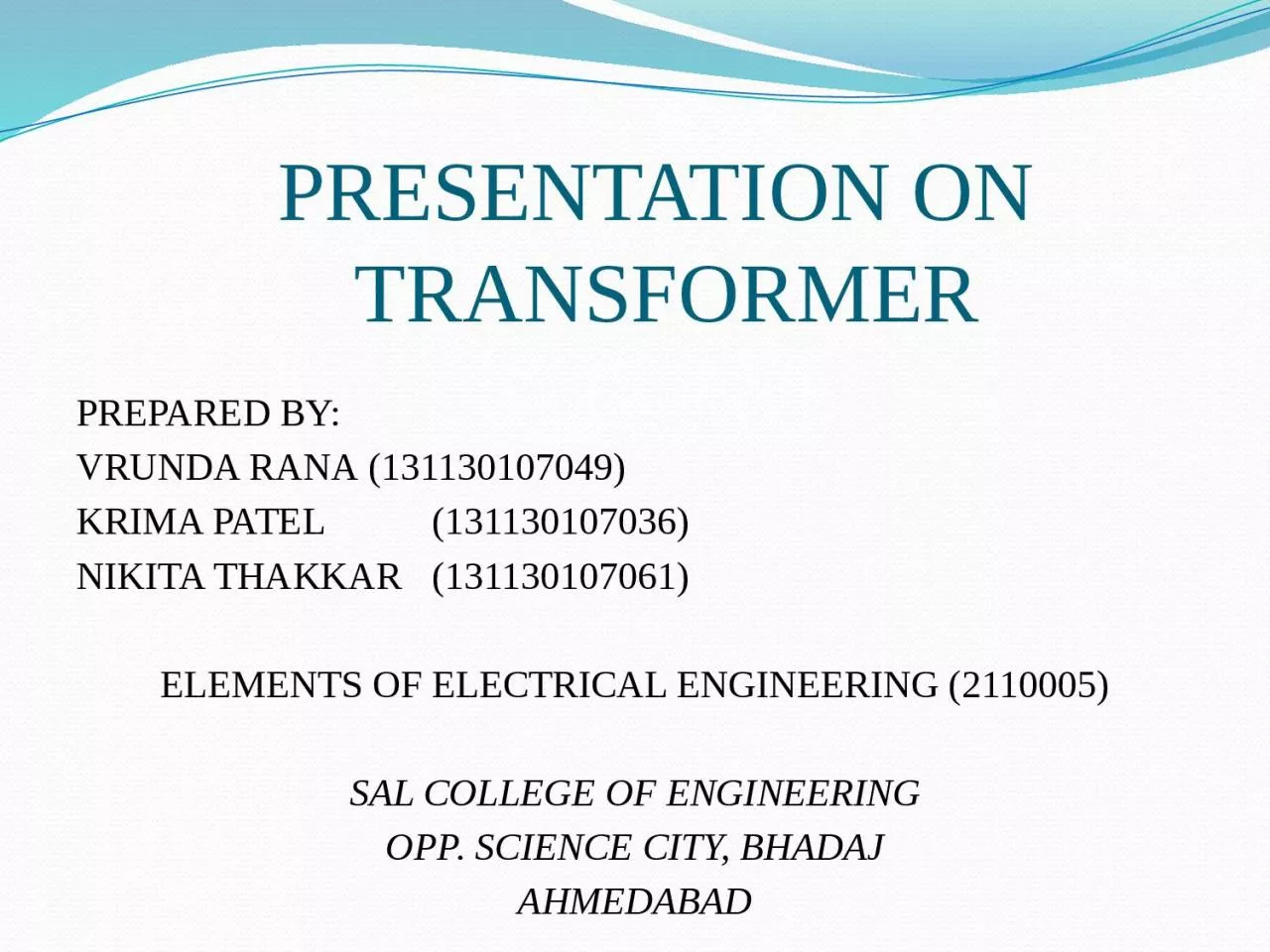

PREPARED BY VRUNDA RANA 131130107049 KRIMA PATEL 131130107036 NIKITA THAKKAR 131130107061 ELEMENTS OF ELECTRICAL ENGINEERING 2110005 SAL COLLEGE OF ENGINEERING OPP SCIENCE CITY BHADAJ ID: 1031076
Download Presentation The PPT/PDF document "PRESENTATION ON TRANSFORMER" is the property of its rightful owner. Permission is granted to download and print the materials on this web site for personal, non-commercial use only, and to display it on your personal computer provided you do not modify the materials and that you retain all copyright notices contained in the materials. By downloading content from our website, you accept the terms of this agreement.
1. PRESENTATION ON TRANSFORMERPREPARED BY:VRUNDA RANA (131130107049)KRIMA PATEL (131130107036)NIKITA THAKKAR (131130107061)ELEMENTS OF ELECTRICAL ENGINEERING (2110005)SAL COLLEGE OF ENGINEERINGOPP. SCIENCE CITY, BHADAJAHMEDABAD
2. INTRODUCTIONThe transformer is a static device which is used to transfer electrical energy from one ac circuit to another ac circuit. Input to a transformer and output from a transformer both are alternating quantities (AC).Electrical energy is generated and transmitted at an extremely high voltages. The voltage is to be then reduced to a lower value for its domestic and industrial use.This is done by using a transformer.
3. The power transmission system using transformers is shown in figure.When the transformer changes the voltage level, it changes the current level also.
4. Basic PrincipleThe primary winding is connected to the single – phase ac supply, an ac current starts flowing through it.
5. The ac primary current produces an alternating flux (Ф) in the core.Most of this changing flux gets linked with the secondary winding through the core.The varying flux will induce voltage into the secondary winding according to the faraday’s laws of electromagnetic induction.Voltage level change but frequency i.e. time period remains same. There is no electrical contact between the two winding, an electrical energy gets transferred from primary to the secondary.
6. A simple transformer consists of two electrical conductors called the primary winding and the secondary winding.Energy is coupled between the windings by the time varying magnetic flux that passes through( links) both primary and secondary windings.
7. Can the transformer operate on DC?Answer: NOThe transformer action does not take place with a direct current of constant magnitude.Because with a DC primary current, the flux produced in the core is not alternating but it is of constant value.As there is no change in the flux linkage with the secondary winding, the induced emf in the secondary is zero.
8. If DC is applied to the primary then there is a possibility of transformer core saturation. If core saturates the primary will draw excessively large current. Therefore application of DC should be avoided.
9. Transformer Types The transformer are of different types depending on the arrangement of the core and the winding as follows.Core Type Shell Type Berry TypeThe magnetic core is a stack of thin silicon-steel laminations about 0.35 mm thick for 50 Hz transformer. In order to reduce the eddy current losses, these laminations are insulated from one another by thin layers of varnish.
10. Core Type Transformer
11. Shell Type Transformer
12. Sr. NoCore Type Transformer Shell Type Transformer1. The core has only one window.The core has two windows.2. Winding encircles the core.Core encircles the windings.3. Cylindrical windings are used.Sandwich type windings are used.4.Easy to repair.It is not so easy to repair.5. Better cooling since more surface is exposed to the atmosphere.Cooling is not very effective.
13. Construction of TransformerThe Most important parts of a transformer are the windings (coils) and the core.Some other parts such as suitable tank, conservator, bushings, breather, explosion vent etc. are also used along with the core and windings.
14. Applications Step – up and Step – down Voltage Measurement of current in single and three phase systemMeasurement of voltage in single and three phase systemMeasurement of powerMeasurement of Energy
15. Thank You